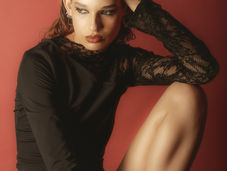V&A Photography Centre Review: 'Tenuous Links' Abound
- Alice Bergin
- Jun 16, 2023
- 3 min read
Updated: Jun 29, 2023
★★☆☆☆

Image Courtesy of the V&A Press Office. Uploaded by Callum Walker, 23/05/2023.
Celebrating the connection between a sexualised hoover, nocturnal wildlife, a rocket launch and the indigenous populations of Lapland is a tough challenge, and one that the V&A has set itself unnecessarily in their brand new Photography Centre.
‘Photography’, as we are reminded at repeated intervals throughout the ‘Sir Elton John and David Furnish’ gallery, ‘is embedded in the story of the V&A’ as it has been collecting photographs since the 1850s, resulting in ‘one of the largest and most varied’ collections in the world. This 7-room, permanent display is long overdue and undeniably impressive, as navigation of the gallery space is punctuated by a stunning photography library (complete with a gilt ‘Kusama Gallery’), and a deepfake drag cabaret (pictured below).
In the initial two rooms, however, curators have selected what they are calling ‘Sparks from the Collection’ in a feeble attempt to suggest that the apparently random selection of images they have arranged are actually all connected by ‘Energy’. The tenuousness of this link is made explicit as the introductory text points out that ‘Energy’ could include not only solar, nuclear, wind etc. but also the human form and also religion and also the camera and also photography itself. In attempting to forge a tie between these supposedly specially selected ‘Sparks’ from the archives, curators have identified a link between all of photography.
Some images fit the ‘Energy’ theme well. Nuclear explosions and Muybridge’s stills of the body in motion, for instance. But other images like a garden fox, for example, urge the viewer to reach for such tenuous links to ‘Energy’ that practically any subject could have found its place. Recognising that some viewers may be struggling to join the dots, captions hastily add phrases like ‘energy bursts out of the pictures’, which embarrassingly underlines the flimsiness of the theme.

Image Courtesy of the V&A Press Office. Uploaded by Callum Walker, 23/05/2023.
Unfortunately, the result is that incredibly moving stills from terrorist attacks and acts of political resistance become a little lost when considered in this way. Considering Amirali Ghasemi or Joana Choumali’s painful work under the umbrella of ‘Energy’ seems reductive. Curators have attempted to side-step their wobbly linking here with a quote from Choumali in which she states that, during the terrorist attacks on the Cote d’Ivoire which she photographed in 2016, ‘the town’s energy was different, as if life was painfully running in melancholic slow motion. Adding embroidery was an act of channelling hope and resilience’. The tie between energy, hope and resilience would have worked well if photographs centred on oppression and resistance were grouped, allowing for a connection and contextualisation that would highlight their strength and import as works of art, which is, surely, the purpose of curation.
Though the final few rooms are intended to bring us into ‘Photography Now’, the ‘Wildlife Photographer of the Year’ exhibition, housed down the road in the Natural History Museum, is doing a far better job of exemplifying the wonders of contemporary photography. In the V&A’s final room, we are given a quick insight into the basic workings of a camera, but to introduce a section on photographic technology and exclude anything post-19th century, let alone the novel techniques achieved by smartphones and drones, is an oversight. Jake Elwes’ deepfake drag cabaret ‘The Zizi Show’ in the third room did explore the intersection of art, identity, and AI, but many bemused visitors, drifting off into ‘Silverware’ next door, were asking ‘what’s that got to do with photography?’
Temporary exhibitions at the V&A have often featured fantastic ‘sparks’ from the photography archives, particularly in the fields of fashion and design for which it is internationally renowned. When the Photography Centre was first unveiled, Hepburn-esque Vogue shoots sprung to mind, so the distinct absence of fashion from the collection begs explanation. Though the images included are certainly exquisite, it feels as though someone thought arranging smaller, comprehensible groups of works with common themes was impossible in the V&A’s vast Victorian spaces, so everything has been forced in under one umbrella, which, ultimately, is struggling to encompass it all.
The V&A Photography Centre is open now and is free to access.
Edited by Samuel Blackburn
























Comments